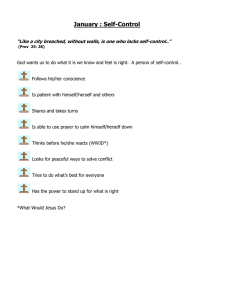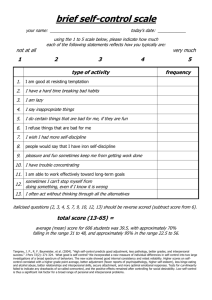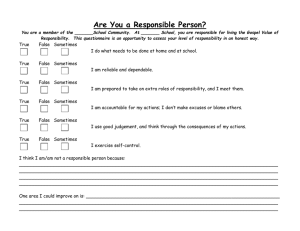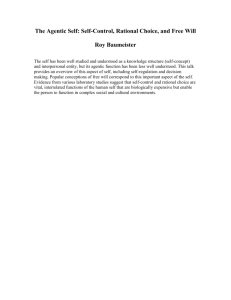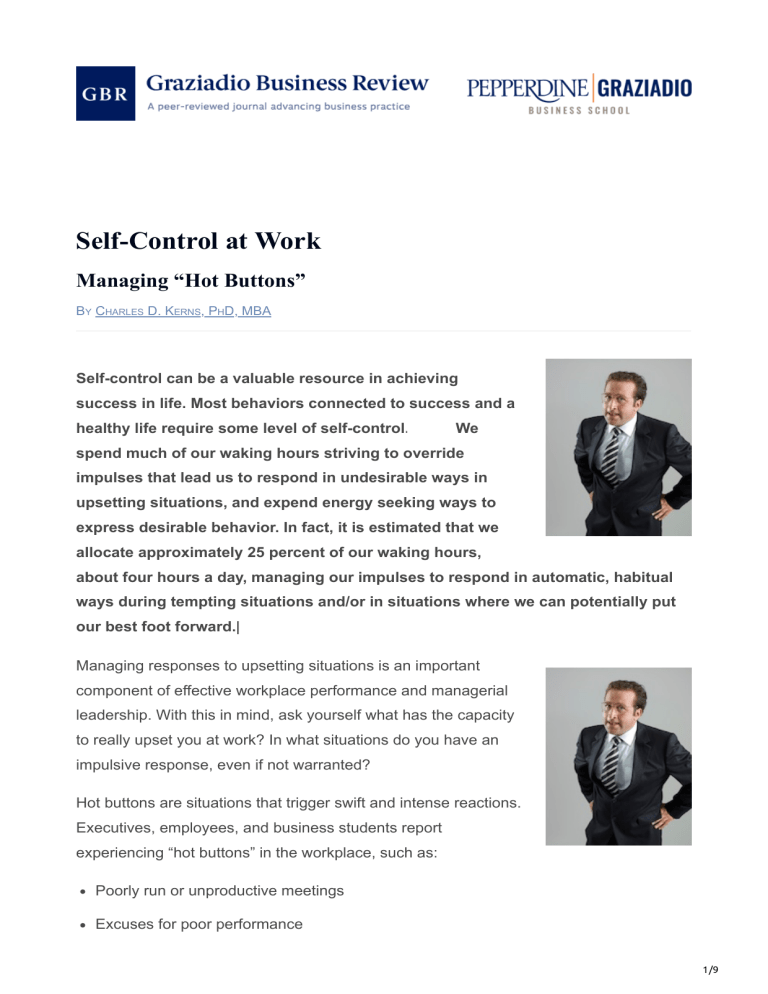
gbr.pepperdine.edu/2013/12/self-control-at-work/ 2013 VOLUME 16 ISSUE 3 Self-Control at Work Managing “Hot Buttons” BY CHARLES D. KERNS, PHD, MBA Self-control can be a valuable resource in achieving success in life. Most behaviors connected to success and a healthy life require some level of self-control.[1] [2] We spend much of our waking hours striving to override impulses that lead us to respond in undesirable ways in upsetting situations, and expend energy seeking ways to express desirable behavior. In fact, it is estimated that we allocate approximately 25 percent of our waking hours, about four hours a day, managing our impulses to respond in automatic, habitual ways during tempting situations and/or in situations where we can potentially put our best foot forward.[3] Managing responses to upsetting situations is an important component of effective workplace performance and managerial leadership. With this in mind, ask yourself what has the capacity to really upset you at work? In what situations do you have an impulsive response, even if not warranted? Hot buttons are situations that trigger swift and intense reactions. Executives, employees, and business students report experiencing “hot buttons” in the workplace, such as: Poorly run or unproductive meetings Excuses for poor performance 1/9 Dishonesty Habitual lateness Over communicating For yourself, consider the following: What are my hot buttons at work? What do I tend to do when I am faced with a hot button situation at work? Given the significant amount of time people spend in the workplace, effectively exercising self-control is important. The strength to change one’s automatic undesirable reactions can be helpful in enhancing personal effectiveness and advancing one’s career, which requires self-control. After defining self-control and connecting it to a maturity index, this article describes a multimodal framework, presents a self-control cycle, and an example application.[4] Self-Control and the Maturity Index Current definitions across theories of self-control concur that self-control is the capacity to change or inhibit dominant response tendencies while managing behavior, thoughts, and emotions. This includes altering inner responses to block undesired behavioral response patterns and to promote performance of desired behaviors. Individuals high in self-control tend to engage in deliberative processing while taking a broad perspective. Research also indicates that these people engage less frequently in resisting temptations because they tend to avoid problematic circumstances. It seems that individuals with strong selfcontrol may develop and stop habits more effectively than others. Those lower in selfcontrol, in contrast, seem to depend on an impulsive system that is associated with expressing automatic habitual response patterns to specific situations.[5] [6] [7] Whether one is dispositionally high or low in self-control, it is important for one to know what has the capacity to upset him or her and produce a strong, negative, and undesired reaction in the workplace. Knowing one’s hot buttons can be the starting place to becoming stronger in inhibiting undesired behaviors and promoting the performance of desired behavioral patterns. This self-awareness may be especially useful for individuals who see themselves as lacking in self-control. For individuals with higher levels of selfcontrol, knowing their hot buttons can help them anticipate and proactively decide on a plan of action when faced with upsetting circumstances. 2/9 Over the past 30 years the author has taught business students, as well as executives and their people, to use a maturity index in order to gauge how well they are responding to hot button situations. The maturity index is an informal personal reflection of how well an individual dealt with a specific situation. Ask yourself, on a scale of 0 to 10, how mature were your reactions in a given situation? Were your reactions based on careful consideration and objective facts? Or was your reaction an unfiltered personal response? A rating of 10 means that the individual perceives that he or she responded in a poised, professional, and situationally appropriate manner. In contrast, a rating in the lower range indicates that the response lacked professionalism, was inappropriate to the situation, and/or reflected an undesired yet dominant response tendency. I encourage you to strive for a rating of 8 or higher on the maturity index in all hot button situations. Higher ratings generally indicate a consistent and effective response to personally challenging situations.[8] In practice, reactions to hot button situations are varied and can either promote or detract from personal effectiveness. In most cases, individuals’ reactions tend to fall into five response modalities. B.A.S.I.C. Response Modalities Five separate but interactive response modalities relate to human personality. The author uses an analysis of the five response modalities, identified using the acronym B.A.S.I.C., to help individuals identify and proactively develop responses to hot button situations. The components in the B.A.S.I.C. response modalities are: B = Behavior which relates to observable actions A = Affect or psychological emotions S = Sensation or physical feelings within one’s body I = Image or mental imagery/pictures in the mind C = Cognition or thoughts/covert self-talk In any situation an individual will react using any or all of these modalities. Most individuals, however, seem to have a primary mode and secondary modality which is triggered by the activation of their primary mode. For example, one’s self-talk (C = Cognition) can lead to an emotion like anger (A = Affect). It is important to note that the five response modalities may be expressed positively or negatively depending on the 3/9 situation and the respondent’s level of self-control. (Positive and negative dimensions of a modality profile will be presented later to show how both types of reactions can be connected to a specific workplace hot button situation.) This five-dimension framework was adapted from the multimodal approach developed by Arnold Lazarus in the 1970s. He believed that in order to effectively change a response to a troubling situation individuals need to diagnose and proactively alter their reactions. The current modality profile of five responses discussed in this article is more business practitioner friendly than Lazarus’, which is more clinically oriented. The current framework has been adapted by the author to fit business operating environments and workplaces.[9] Self-Control Cycle A practical way of dealing with troubling hot button situations, and your reactions to them, is depicted in the self-control cycle framework shown in Figure 1. 4/9 Figure 1: Self-Control Cycle The first step in the self-control cycle involves reading the situation. In reading the situation, an individual identifies hot button situations, situations that have the capacity to upset him or her in the workplace and have the potential to elicit a strong undesired reaction. An undesirable response may likely have a negative impact on the respondent and those around that individual. Once you understand what situations raise an issue, the second step is to look at your B.A.S.I.C. reactions across the five response modalities (example provided in the next section). After completing a “B.A.S.I.C. Modality Reaction Profile” for a given situation, the individual decides what action is needed given one’s reading of the situation and understanding of one’s B.A.S.I.C Modality Profile. An individual then proceeds to take effective action and assess the impact of his or her response on the situation. When actions are effective, adaptations are not needed. However, adaptations in one’s response pattern may be indicated if desired impacts are not being achieved. This framework is consistent with contemporary models of self-control. It is intended to help encourage desirable behavior while helping to inhibit undesirable response tendencies. It can be applied to a variety of hot button workplace situations in a deliberate and conscientious way.[10] It is important to recognize, however, that managing significant hot button issues and applying the self-control cycle can be challenging and may require practice for success. Applying the Self-Control Cycle: An Example Bill is an industrial products salesperson who is expected to attend a regularly scheduled sales management meeting run by his boss, the regional sales manager. Bill is quite upset, frustrated, and angry about having to attend these meetings. He believes his boss runs the meetings poorly and that they are a complete waste of time. As a result, his attendance at these meetings is less than 50 percent. He has become skilled at making excuses for not attending. As part of a coaching program Bill was asked to track his B.A.S.I.C. reactions to this situation, which yielded the following negative reactions on his B.A.S.I.C Modality Profile: Behavior = Makes excuses to avoid attending sales management meetings and when he does attend he acts disengaged. Affect = Frustration and anger. 5/9 Sensation = Experiences tension in neck and has headaches. Images = Has mental pictures of the meeting being run poorly and extending beyond the scheduled time period. Cognition = Tells himself repeatedly that the meetings are a waste of time and that nothing productive or good can come by participating in them. With these negative B.A.S.I.C. reactions in hand, and with some coaching, Bill decided to develop a positive B.A.S.I.C. Modality Profile. This positive profile was designed to counter his undesired response tendencies to the hot button situation of having to attend these unproductive meetings. His positive modality profile included the following: Behavior = Ask boss for the meeting agenda in advance and proactively talk with him about where he (Bill) could best contribute during the meeting. Participate in an engaged way by asking more open-ended questions and suggesting to his boss during the meeting that the agenda be kept moving forward. Affect = During the meeting explicitly make one to three positive comments about some aspect of what is being discussed. Track any positive emotion and/or positive feelings he observes in himself and others during the meeting. Sensation = During the meeting explicitly track his tension level vs. level of calmness in relationship to topics being reviewed. Track any positive physical feelings/sensations he experiences during the proceedings. Images = Before, during, and after the meeting bring to mind images which reflect improvement in the productivity of the meetings and/or of him coping effectively with whatever occurs during the meeting. Cognition = Develop a sentence/statement that disputes or counters his strong pattern of negative self-talk about attending these meetings. (With coaching, Bill developed this positive self-talk statement, “I want to become a regional sales manager so attending these meetings is important to my career success. If I am going to attend I need to be fully engaged and participate to bring out the best in myself and others. I need to act this way even if the meeting has negative moments.”) The positive modality profile represents a behavioral substitution or incompatible behavior paradigm in relation to the negative modality profile. Each of the five negatively stated modalities is countered with an incompatible/substitute positive response. For example, not going to the meeting is replaced with going to the meeting and being fully engaged. 6/9 After completing both the negative and positive aspects of his multi-modal profile, Bill decided that he needed to focus on his primary modality trigger which was “C” (Cognition or negative self-talk). Bill discovered that he habitually espoused covert negative comments (“C”) which in turn triggered the negative emotions (“A”) of anger and frustration. The action he took to counter this was to practice positive self-talk before, during, and after each of the sales management meetings. He engaged in a response pattern that was incompatible with his undesired behavior. Bill inhibited his negative self talk and substituted a more desirable positive self talk response. Following the implementation of this approach, his attendance and engagement in these meetings significantly improved. During this period of self-control management, Bill found that changing his pre-meeting behavior from finding excuses for not attending the meetings to proactively engaging his boss around topics of mutual interest in advance of each meeting was also effective. Overall, Bill improved his personal effectiveness and kept his career on a positive trajectory. Summary Remarks Self-control in the workplace can lead to healthier and more productive relationships. More specifically, becoming aware of and effectively managing your responses to hot button situations can spell the difference between advancing or derailing your career. Think of self-control as a muscle that needs to be exercised to be strengthened, rested to be replenished, and generally managed to avoid depletion.[11] With this in mind, you are encouraged to identify those situations that have the potential to elicit strong undesirable reactions from you at work and to consider using the framework offered here to help guide you toward enhanced personal effectiveness in dealing with these hot button situations now and in the future. [1] J. Tangney, R.F. Baumeister and A.L. Boone, “High self-control predicts good adjustment, less pathology, better grades, and interpersonal success,” Journal of Personality, 72, (2004): 271-324. [2] K.D. Vohs and R.F. Baumeister. “Understanding self-regulation,” in R.F. Baumeister and K.D. Vohs, (Eds.), Handbook of Self-Regulation: Research, Theory and Applications, (New York: Guilford Press, 2004). [3] R.F. Baumeister and J. Tierney. Willpower: Rediscovering the Greatest Human Strength, (New York: Penguin Press, 2011). 7/9 [4] A multi-model framework for identifying negative reactions to challenging situations along with more effective responses to these circumstances is provided. This multi-model framework for adapting to challenging life situations is applied to the workplace and an example application is offered. [5] J. Metcalfe and W. Mischel, “A hot/cool system analysis of delay of gratification: Dynamics of willpower,” Psychological Review, 106, (1999): 3-19. [6] W. Hoffman, M. Friese, M. and F. Strack, “Impulse and self-control from a dualsystems perspective,” Perspectives on Psychological Science, 4, (2009): 162-176. [7] F. Righetti, C. Finkenauer, and E.J. Finkel, “Low self-control promotes the willingness to sacrifice in close relationships,” Psychological Science, 24, (2013): 1533-1540. [8] A.L. Duckworth and M.L. Kern, “A Meta-Analysis of the Convergent Validity of SelfControl Measures,” Journal of Research in Personality, 45, (2011): 259-268. Beyond assessment tools like the maturity index used in executive coaching settings there are a diverse array of other instruments available to assess self-control. This particular metaanalytic study considered over 100 different measures designed to assess self-control. [9] A.A. Lazarus, Behavior Theory and Beyond (New York: McGraw-Hill, 1971). A.A. Lazarus. Brief but Comprehensive Psychotherapy: The Multimodal Way, (New York: Springer Publishing, 1997). S. Palmer, “Multimodal Coaching and Its Application to Workplace, Life and Health Coaching,” Danish Journal of Coaching Psychology, 2, (2012): 91-98. [10] D.T.D. de Ridder, G. Lensvelt-Mulders, C. Finkenauer, F.M. Stok, and R.F. Baumeister, “Taking Stock of Self-Control: A Meta-Analysis of How Trait Self-Control Relates to a Wide Range of Behaviors,” Personality and Social Psychology Review, 16, (2012): 76-99. [11] M. Muraven and R.F. Baumeister, “Self-Regulation and Depletion of Limited Resources: Does Self-Control Resemble a Muscle?” Psychological Bulletin, 126, (2000): 247-259. M.S. Hagger, C. Wood; C. Stiff and N.L.D. Chatzisarantis, “Ego depletion and the strength model of self-control: A meta-analysis,“ Psychological Bulletin, 136 (2010): 495-525. While it is beyond the scope of the current article to explore the self-regulatory strength model of self-control further, it is indeed interesting and useful to view self-control as a resource that resembles a muscle. Self-Control needs to be managed effectively to strengthen it and it also needs to be replenished to avoid being depleted. 8/9 AUTHOR OF THE ARTICLE Charles D. Kerns, PhD, MBA Charles D. Kerns, PhD, MBA, is a professor of applied behavioral science at the Graziadio School of Business and Management. He has more than 30 years of business, management, and consulting experience. Through his private consulting firm, Corperformance, he has implemented performance management programs and systems to help companies from many industries maximize their results. Since 1980, he has taught in almost every program in the Graziadio School, first as an adjunct faculty member, then, since 2000, as a member of the full-time faculty. He has also served as the associate dean for Academic Affairs. Dr. Kerns holds a Diplomate, ABPP, in both Industrial-Organizational Psychology and OrganizationalBusiness Consulting Psychology. Graziadio Business School | Copyright © 2013 Pepperdine University 9/9
